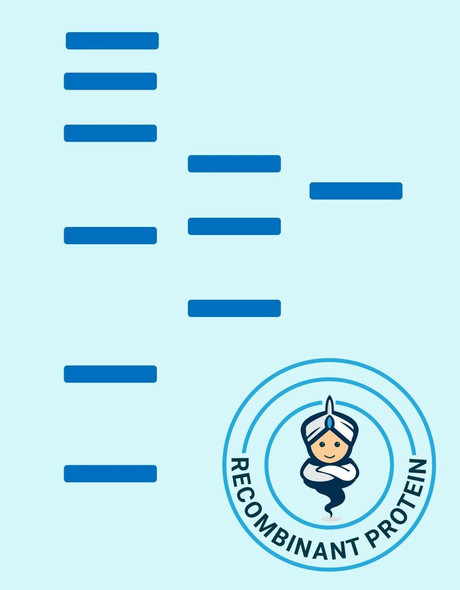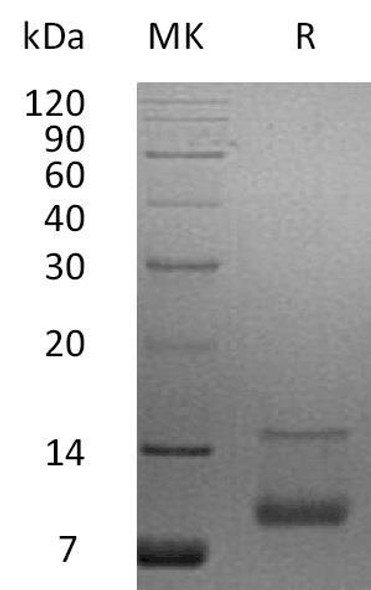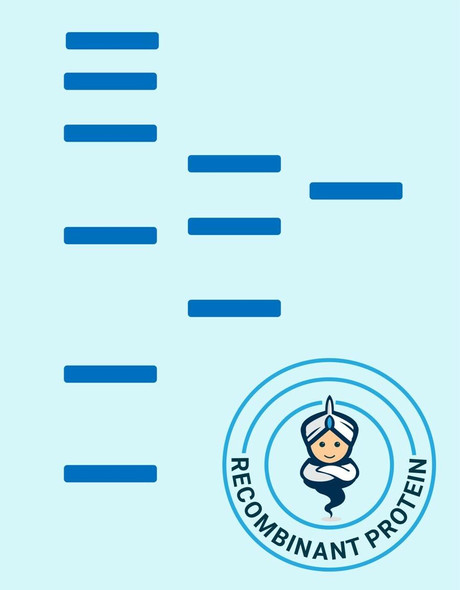Description
| Product Name: | Human IGF1 Recombinant Protein |
| Product Code: | RPPB0422 |
| Size: | 100µg |
| Species: | Human |
| Target: | IGF1 |
| Synonyms: | Somatomedin C, IGF-I, IGFI, IGF1, IGF-IA, Mechano growth factor, MGF. |
| Source: | Escherichia Coli |
| Physical Appearance: | Sterile Filtered White lyophilized (freeze-dried) powder. |
| Formulation: | IGF1�R36Q Lyophilized from a 0.2 �m filtered concentrated solution in 20 mM PB and 150 mM NaCl, pH 5.4. |
| Solubility: | It is recommended to reconstitute the lyophilized IGF1�R36Q in sterile 18M?-cm H2O not less than 100�g/ml, which can then be further diluted to other aqueous solutions. |
| Stability: | Store at 4°C if entire vial will be used within 2-4 weeks.Store, frozen at -20°C for longer periods of time. For long term storage it is recommended to add a carrier protein (0.1% HSA or BSA). Avoid multiple freeze-thaw cycles. |
| Purity: | Greater than 95.0% as determined by SDS-PAGE. |
| Amino Acid Sequence: | GPETLCGAEL VDALQFVCGD RGFYFNKPTG YGSSSQRAPQ TGIVDECCFR SCDLRRLEMY CAPLKPAKSA |
The somatomedins, or insulin-like growth factors (IGFs), comprise a family of peptides that takes part in mammalian growth and development. IGF1 mediates various growth-promoting effects of growth hormone (GH; MIM 139250). Early studies showed that growth hormone did not directly stimulate the incorporation of sulfate into cartilage, but rather acted through a serum factor, termed 'sulfation factor,' which later became known as 'somatomedin' (Daughaday et al., 1972). 3 main somatomedins have been characterized: somatomedin C (IGF1), somatomedin A (IGF2; MIM 147470), and somatomedin B (MIM 193190) (Rotwein, 1986; Rosenfeld, 2003).
IGF1 R36Q Human Recombinant produced in E.Coli is a single, non-glycosylated polypeptide chain containing 70 amino acids and having a molecular mass of Approximately 7.6kDa.The IGF1 R36Q is purified by proprietary chromatographic techniques.
| UniProt Protein Function: | IGF1: The insulin-like growth factors, isolated from plasma, are structurally and functionally related to insulin but have a much higher growth-promoting activity. May be a physiological regulator of [1-14C]-2-deoxy-D-glucose (2DG) transport and glycogen synthesis in osteoblasts. Stimulates glucose transport in rat bone-derived osteoblastic (PyMS) cells and is effective at much lower concentrations than insulin, not only regarding glycogen and DNA synthesis but also with regard to enhancing glucose uptake. Defects in IGF1 are the cause of insulin-like growth factor I deficiency (IGF1 deficiency). IGF1 deficiency is an autosomal recessive disorder characterized by growth retardation, sensorineural deafness and mental retardation. Belongs to the insulin family. 3 isoforms of the human protein are produced by alternative splicing. |
| UniProt Protein Details: | Protein type:Secreted; Secreted, signal peptide; Motility/polarity/chemotaxis Chromosomal Location of Human Ortholog: 12q23.2 Cellular Component: insulin-like growth factor binding protein complex; extracellular space; plasma membrane; extracellular region Molecular Function:integrin binding; insulin-like growth factor receptor binding; protein binding; growth factor activity; hormone activity; insulin receptor binding Biological Process: muscle development; positive regulation of transcription, DNA-dependent; chondroitin sulfate proteoglycan biosynthetic process; exocrine pancreas development; glycolate metabolic process; water homeostasis; positive regulation of glucose import; positive regulation of fibroblast proliferation; proteoglycan biosynthetic process; inner ear development; positive regulation of DNA binding; muscle hypertrophy; platelet activation; positive regulation of protein import into nucleus, translocation; positive regulation of mitosis; regulation of establishment and/or maintenance of cell polarity; positive regulation of phosphoinositide 3-kinase cascade; cell activation; positive regulation of peptidyl-tyrosine phosphorylation; branching morphogenesis of a tube; insulin-like growth factor receptor signaling pathway; response to heat; regulation of gene expression; positive regulation of transcription from RNA polymerase II promoter; alveolus development; positive regulation of epithelial cell proliferation; negative regulation of apoptosis; positive regulation of insulin-like growth factor receptor signaling pathway; myoblast proliferation; positive regulation of smooth muscle cell proliferation; positive regulation of glycogen biosynthetic process; positive regulation of activated T cell proliferation; signal transduction; positive regulation of smooth muscle cell migration; negative regulation of cell proliferation; platelet degranulation; glial cell differentiation; positive regulation of MAPKKK cascade; mammary gland development; positive regulation of cell proliferation; DNA replication; skeletal development; positive regulation of granule cell precursor proliferation; phosphoinositide-mediated signaling; multicellular organism growth; regulation of multicellular organism growth; myotube cell development; satellite cell compartment self-renewal involved in skeletal muscle regeneration; myoblast differentiation; positive regulation of osteoblast differentiation; positive regulation of protein kinase B signaling cascade; cell proliferation; cellular protein metabolic process; positive regulation of tyrosine phosphorylation of Stat5 protein; positive regulation of glycolysis; Ras protein signal transduction; blood vessel remodeling; positive regulation of Ras protein signal transduction; blood coagulation; cell motility; positive regulation of DNA replication Disease: Insulin-like Growth Factor I Deficiency |
| NCBI Summary: | The protein encoded by this gene is similar to insulin in function and structure and is a member of a family of proteins involved in mediating growth and development. The encoded protein is processed from a precursor, bound by a specific receptor, and secreted. Defects in this gene are a cause of insulin-like growth factor I deficiency. Several transcript variants encoding different isoforms have been found for this gene.[provided by RefSeq, Mar 2009] |
| UniProt Code: | P05019 |
| NCBI GenInfo Identifier: | 124263 |
| NCBI Gene ID: | 3479 |
| NCBI Accession: | P05019.1 |
| UniProt Secondary Accession: | P05019,P01343, Q14620, B2RWM7, E9PD02, |
| UniProt Related Accession: | P05019 |
| Molecular Weight: | 17,762 Da |
| NCBI Full Name: | Insulin-like growth factor I |
| NCBI Synonym Full Names: | insulin-like growth factor 1 (somatomedin C) |
| NCBI Official Symbol: | IGF1�� |
| NCBI Official Synonym Symbols: | IGFI; IGF-I; IGF1A�� |
| NCBI Protein Information: | insulin-like growth factor I; MGF; IGF-IA; IGF-IB; somatomedin-C; mechano growth factor; insulin-like growth factor IA; insulin-like growth factor IB |
| UniProt Protein Name: | Insulin-like growth factor I |
| UniProt Synonym Protein Names: | Mechano growth factor; MGF; Somatomedin-C |
| Protein Family: | Insulin-like growth factor |
| UniProt Gene Name: | IGF1�� |
| UniProt Entry Name: | IGF1_HUMAN |










